The Different Effects of Organic Amines on Synthetic Metal Phosphites/Phosphates
Abstract
:1. Introduction
2. Materials and Methods
2.1. Materials and Instruments
2.2. Synthesis and Initial Characterization
2.3. Determination of Crystal Structure
3. Results and Discussion
3.1. Structure and Characterization
3.2. Thermogravimetric Analysis
3.3. Roles of Organic Amines
4. Conclusions
Supplementary Materials
Author Contributions
Funding
Conflicts of Interest
References
- Li, J.; Corma, A.; Yu, J. Synthesis of new zeolite structures. Chem. Soc. Rev. 2015, 44, 7112–7127. [Google Scholar] [CrossRef] [PubMed] [Green Version]
- Cheetham, A.K.; Férey, G.; Loiseau, T. Open-framework inorganic materials. Angew. Chem. Int. Ed. 1999, 38, 3268–3292. [Google Scholar] [CrossRef]
- Davis, M.E. Ordered porous materials for emerging applications. Nature 2002, 417, 813–821. [Google Scholar] [CrossRef] [PubMed]
- Dusselier, M.; Davis, M.E. Small-pore zeolites: Synthesis and catalysis. Chem. Rev. 2018, 118, 5265–5329. [Google Scholar] [CrossRef]
- Yang, M.; Fan, D.; Wei, Y.; Tian, P.; Liu, Z. Recent Progress in Methanol-to-Olefins (MTO) Catalysts. Adv. Mater. 2019, 31, 1902181. [Google Scholar] [CrossRef]
- Wilson, S.T.; Lok, B.M.; Messina, C.A.; Cannan, T.R.; Flanigen, E.M. Aluminophosphate molecular sieves: A new class of microporous crystalline inorganic solids. J. Am. Chem. Soc. 1982, 104, 1146–1147. [Google Scholar] [CrossRef]
- Murugavel, R.; Choudhury, A.; Walawalkar, M.G.; Pothiraja, R.; Rao, C.N.R. Metal complexes of organophosphate esters and open-framework metal phosphates: Synthesis, structure, transformations, and applications. Chem. Rev. 2008, 108, 3549–3655. [Google Scholar] [CrossRef]
- Li, Y.; Yu, J.; Xu, R. Criteria for zeolite frameworks realizable for target synthesis. Angew. Chem. Int. Ed. 2013, 52, 1673–1677. [Google Scholar] [CrossRef]
- Ekambaram, S.; Sevov, S.C. Organically Templated Mixed-Valent TiIII/TiIV Phosphate with an Octahedral-Tetrahedral Open Framework. Angew. Chem. Int. Ed. 1999, 38, 372–375. [Google Scholar] [CrossRef]
- Li, T.; Qi, X.; Li, J.; Zeng, H.; Zou, G.; Lin, Z. Using Multifunctional Ionic Liquids in the Synthesis of Crystalline Metal Phosphites and Hybrid Framework Solids. Inorg. Chem. 2018, 57, 14031–14034. [Google Scholar] [CrossRef]
- Gao, F.; Huang, L.L.; Xiu, Z.J.; Yin, Y.Z.; Ma, Y.K.; Bi, Y.F.; Zheng, Z.P. Solvent-free synthesis and room temperature proton conductivity of new cobalt phosphite-oxalates. Crystengcomm 2018, 20, 5544–5550. [Google Scholar] [CrossRef]
- Huang, H.L.; Wang, S.L. An extraordinary boron-mediated 16R-channel-containing trivalent vanadium phosphite with unique solid state redox properties. Chem. Commun. 2010, 46, 6141–6143. [Google Scholar] [CrossRef]
- Rojo, T.; Mesa, J.L.; Lago, J.; Bazan, B.; Pizarro, J.L.; Arriortua, M.I. Organically templated open-framework phosphites. J. Mater. Chem. 2009, 19, 3793–3818. [Google Scholar] [CrossRef]
- Liang, J.; Li, J.Y.; Yu, J.H.; Chen, P.; Fang, Q.R.; Sun, F.X.; Xu, R.R. (C4H12N)2Zn3(HPO3)4: An open-framework zinc phosphite containing extra-large 24-ring channels. Angew. Chem. Int. Edit. 2006, 45, 2546–2548. [Google Scholar] [CrossRef]
- Xing, H.Z.; Yang, W.T.; Su, T.; Li, Y.; Xu, J.; Nakano, T.; Yu, J.H.; Xu, R.R. Ionothermal Synthesis of Extra-Large-Pore Open-Framework Nickel Phosphite 5H3O center dot Ni8(HPO3)9Cl3 center dot 1.5H2O: Magnetic Anisotropy of the Antiferromagnetism. Angew. Chem. Int. Ed. 2010, 49, 2328–2331. [Google Scholar] [CrossRef]
- Lin, H.-Y.; Chin, C.-Y.; Huang, H.-L.; Huang, W.-Y.; Sie, M.-J.; Huang, L.-H.; Lee, Y.-H.; Lin, C.-H.; Lii, K.-H.; Bu, X. Crystalline inorganic frameworks with 56-ring, 64-ring, and 72-ring channels. Science 2013, 339, 811–813. [Google Scholar] [CrossRef] [Green Version]
- Ni, A.-Y.; Mu, Y.; Pan, J.; Han, S.-D.; Shang, M.-M.; Wang, G.-M. An organic–inorganic hybrid zinc phosphite framework with room temperature phosphorescence. Chem. Commun. 2018, 54, 3712–3714. [Google Scholar] [CrossRef]
- Luo, X.C.; Luo, D.B.; Zeng, H.M.; Gong, M.C.; Chen, Y.Q.; Lin, Z.E. A 3,4-Connected Beryllium Phosphite Framework Containing 24-Ring Channels with a Very Low Density. Inorg. Chem. 2011, 50, 8697–8699. [Google Scholar] [CrossRef]
- Luo, X.C.; Gong, M.C.; Chen, Y.Q.; Lin, Z.E. Flux synthesis of two new open-framework zinc phosphites with 16-ring channels. Microporous Mesoporous Mater. 2010, 131, 418–422. [Google Scholar] [CrossRef]
- Tao, C.; Wu, J.; Yan, Y.; Shi, C.; Li, J. A new methylviologen-templated zinc gallophosphate zeolite with photo-/thermochromism, fluorescent and photoelectric properties. Inorg. Chem. Front. 2016, 3, 541–546. [Google Scholar] [CrossRef]
- Wu, J.; Yan, Y.; Liu, B.; Wang, X.; Li, J.; Yu, J. Multifunctional open-framework zinc phosphate| C12H14N2|[Zn6(PO4)4(HPO4)(H2O)2]: Photochromic, photoelectric and fluorescent properties. Chem. Commun. 2013, 49, 4995–4997. [Google Scholar] [CrossRef]
- Wang, C.-M.; Chang, T.-Y.; Lee, L.-W.; Lin, H.-M.; Lu, K.-L.; Lii, K.-H. The first zinc phosphite with remarkable structural and functional transformations. Chem. Commun. 2015, 51, 7824–7826. [Google Scholar] [CrossRef]
- Lin, C.; Pan, F.J.; Li, J.; Chen, Y.P.; Shi, D.E.; Ma, T.Q.; Yang, Y.Q.; Du, X.; Wang, W.; Liao, F.H.; et al. An Open-Framework Aluminophosphite with Face-Sharing AlO6 Octahedra Dimers and Extra-Large 14-Ring Channels. Cryst. Growth Des. 2018, 18, 1267–1271. [Google Scholar] [CrossRef]
- Wang, C.-M.; Chiu, C.-W.; Lin, H.-M.; Lii, K.-H. Synthesis and characterization of three-layered zinc phosphites containing tert-octylamine molecules with template and ligand roles. J. Solid State Chem. 2013, 204, 16–20. [Google Scholar] [CrossRef]
- Wang, X.; Zhou, Y.; Dong, Z.; Meng, C.; Li, X.; Hong, X.; Yang, S. The effects of different dimensional organic amines on synthetic zinc phosphites/phosphates. J. Porous Mater. 2020, 27, 21–28. [Google Scholar] [CrossRef]
- Wang, X.; Yan, Y.; Wu, J.; Zhang, C.; Li, J. Solvothermal syntheses and structures of four indium-phosphite coordination polymers. Crystengcomm 2014, 16, 2266–2272. [Google Scholar] [CrossRef]
- Wang, G.M.; Li, J.H.; Wei, L.; Han, S.D.; Zhao, X.M.; Bao, Z.Z. An open-framework beryllium phosphite with extra-large 18-ring channels. Crystengcomm 2015, 17, 8414–8417. [Google Scholar] [CrossRef]
- Xue, Z.Z.; Pan, J.; Li, J.H.; Wang, Z.H.; Wang, G.M. Synthesis, structure and characterization of two new organic template-directed gallium phosphate/phosphite-oxalates. J. Mol. Struct. 2017, 1138, 1–5. [Google Scholar] [CrossRef]
- Wang, K.C.; Li, T.; Zeng, H.M.; Zou, G.H.; Zhang, Q.H.; Lin, Z.E. Ionothermal Synthesis of Open-Framework Metal Phosphates Using a Multifunctional Ionic Liquid. Inorg. Chem. 2018, 57, 8726–8729. [Google Scholar] [CrossRef]
- Wu, J.; Lou, L.; Liu, H.; Su, T.; Wang, Z.; Li, J. Ionothermal synthesis of a photoelectroactive titanophosphite with a three-dimensional open-framework. Crystengcomm 2019, 21, 5867–5871. [Google Scholar] [CrossRef]
- SAINT, B. A. Inc. 5465 East Cheryl Parkway; SAINT, B. A. Inc.: Madison, WI, USA, 2000; p. 53711. [Google Scholar]
- Sheldrick, G.M. A short history of SHELX. Acta Crystallogr. Sect. A 2008, 64, 112–122. [Google Scholar] [CrossRef] [PubMed] [Green Version]
- Song, X.; Li, Y.; Gan, L.; Wang, Z.; Yu, J.; Xu, R. Heteroatom-stabilized chiral framework of aluminophosphate molecular sieves. Angew. Chem. Int. Ed. 2009, 48, 314–317. [Google Scholar] [CrossRef] [PubMed]
- Chen, P.; Li, J.; Yu, J.; Wang, Y.; Pan, Q.; Xu, R. The synthesis and structure of a chiral 1D aluminophosphate chain compound: D-Co(en)3[AlP2O8]·6.5H2O. J. Solid State Chem. 2005, 178, 1929–1934. [Google Scholar] [CrossRef]
- Xiang, Y.; Zhang, L.W.; Chen, W.H.; Chen, J.Z.; Zeng, Q.X. Synthesis and characterization of a new organically templated aluminophosphite with a chainlike structure. Z. Anorg. Allg. Chem. 2007, 633, 1727–1730. [Google Scholar] [CrossRef]
- Yi, Z.; Chen, C.; Li, S.; Li, G.; Meng, H.; Cui, Y.; Yang, Y.; Pang, W. Hydrothermal synthesis and structural characterization of the first indium phosphite In2(HPO3)3(H2O). Inorg. Chem. Commun. 2005, 8, 166–169. [Google Scholar] [CrossRef]
- Yang, Y.; Zhao, Y.; Yu, J.; Pang, N.; Su, H.; Pang, S. Two neutral open-framework metal phosphites with ten-ring channels constructed by three-, four-, and five-connected centers. Chem. Lett. 2008, 37, 678–679. [Google Scholar] [CrossRef]
- Huang, L.L.; Song, T.Y.; Fan, Y.; Wang, L.P.; Ji, C.X.; Shan, L.; Wang, L. Synthesis and characterization of a new chiral open-framework indium phosphite with intertwined host and guest helices. Microporous Mesoporous Mater. 2012, 149, 95–100. [Google Scholar] [CrossRef]


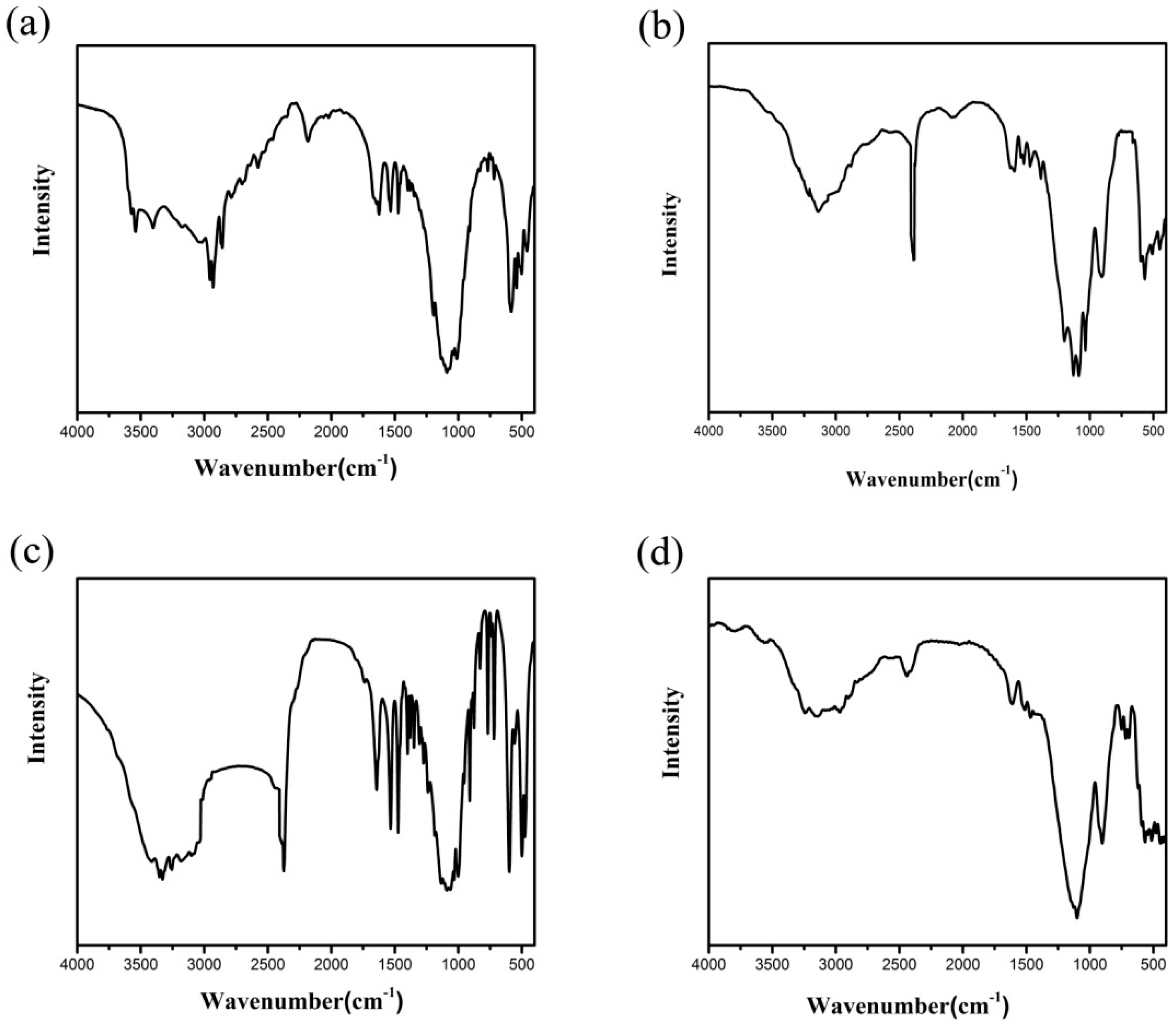
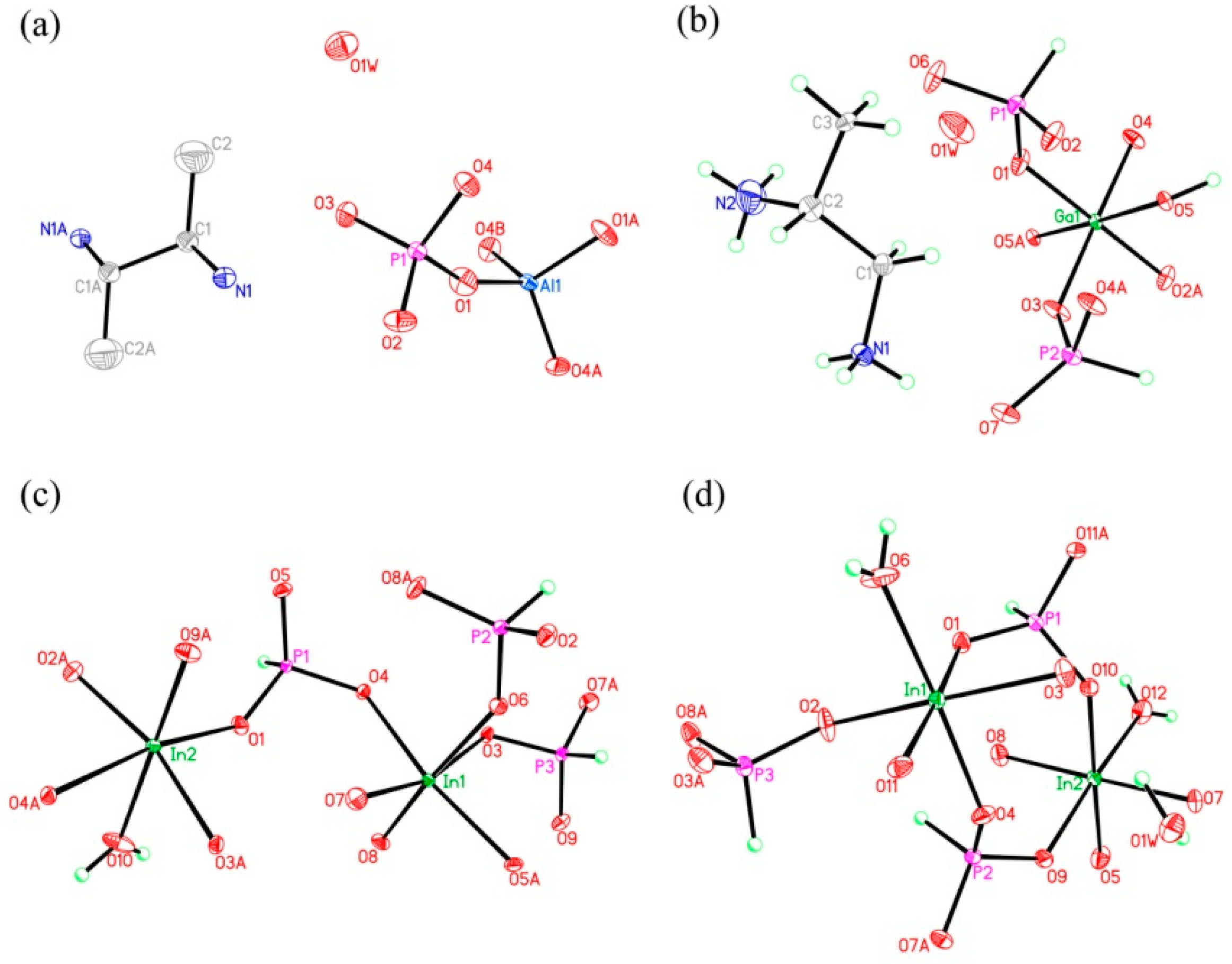
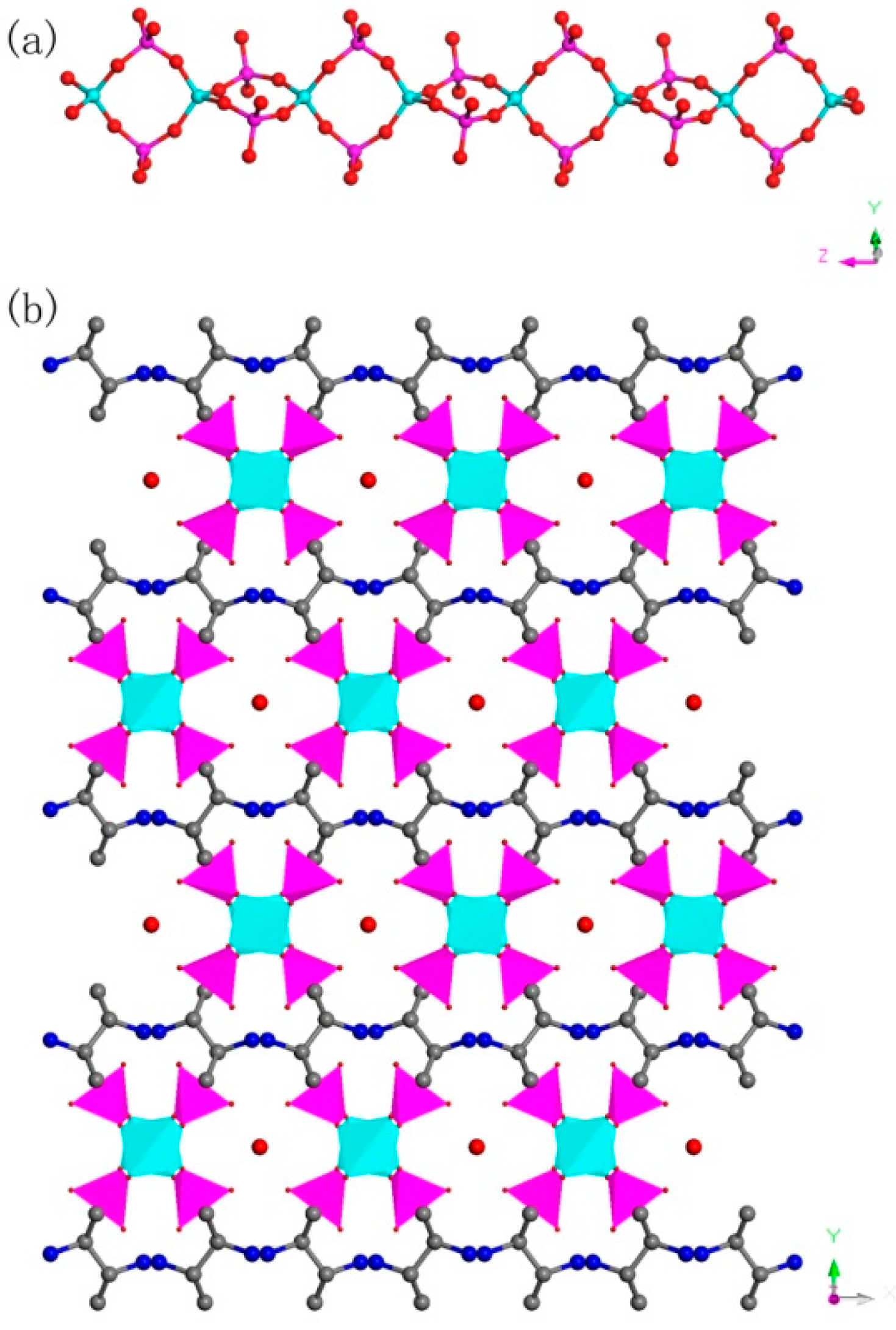
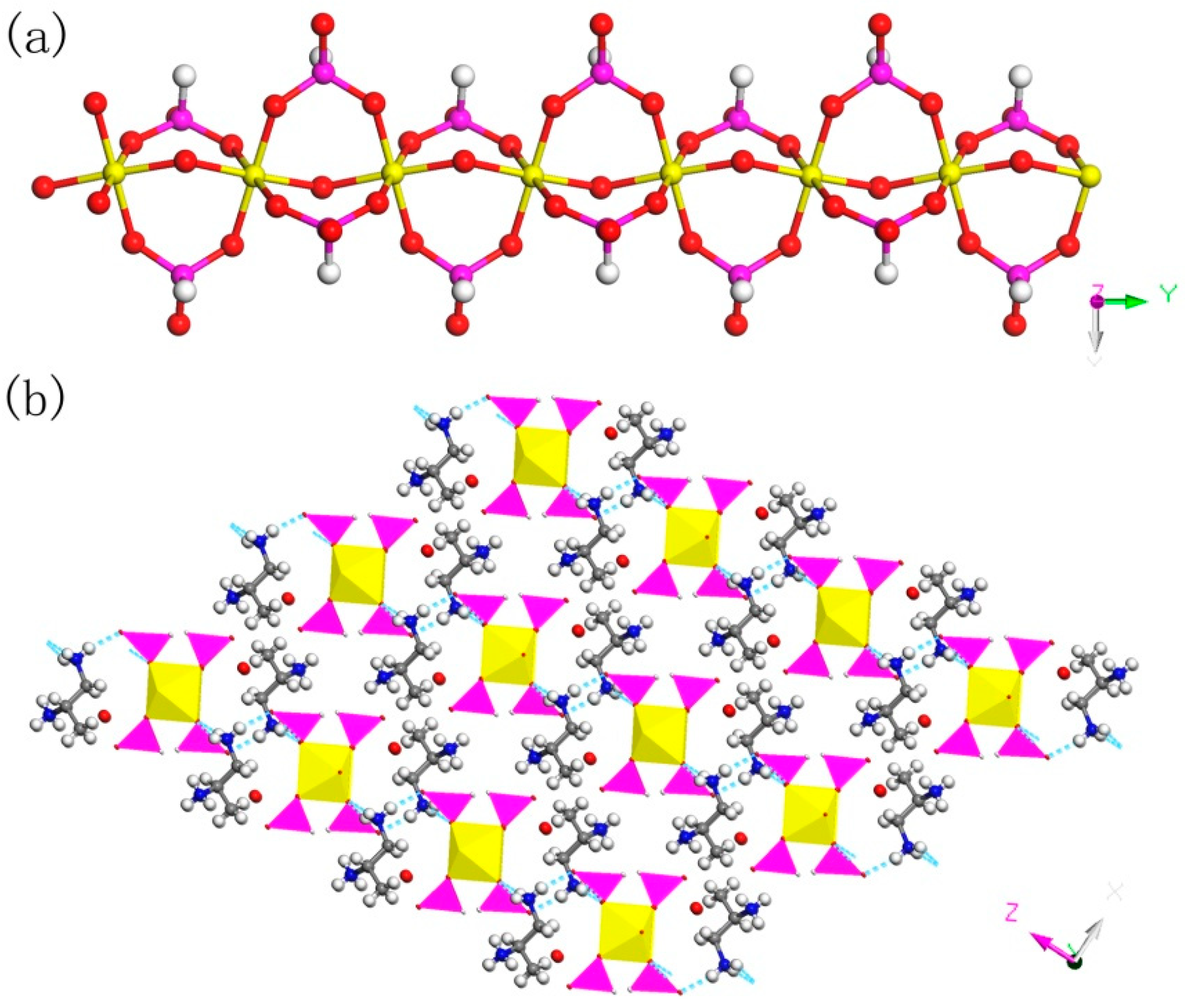

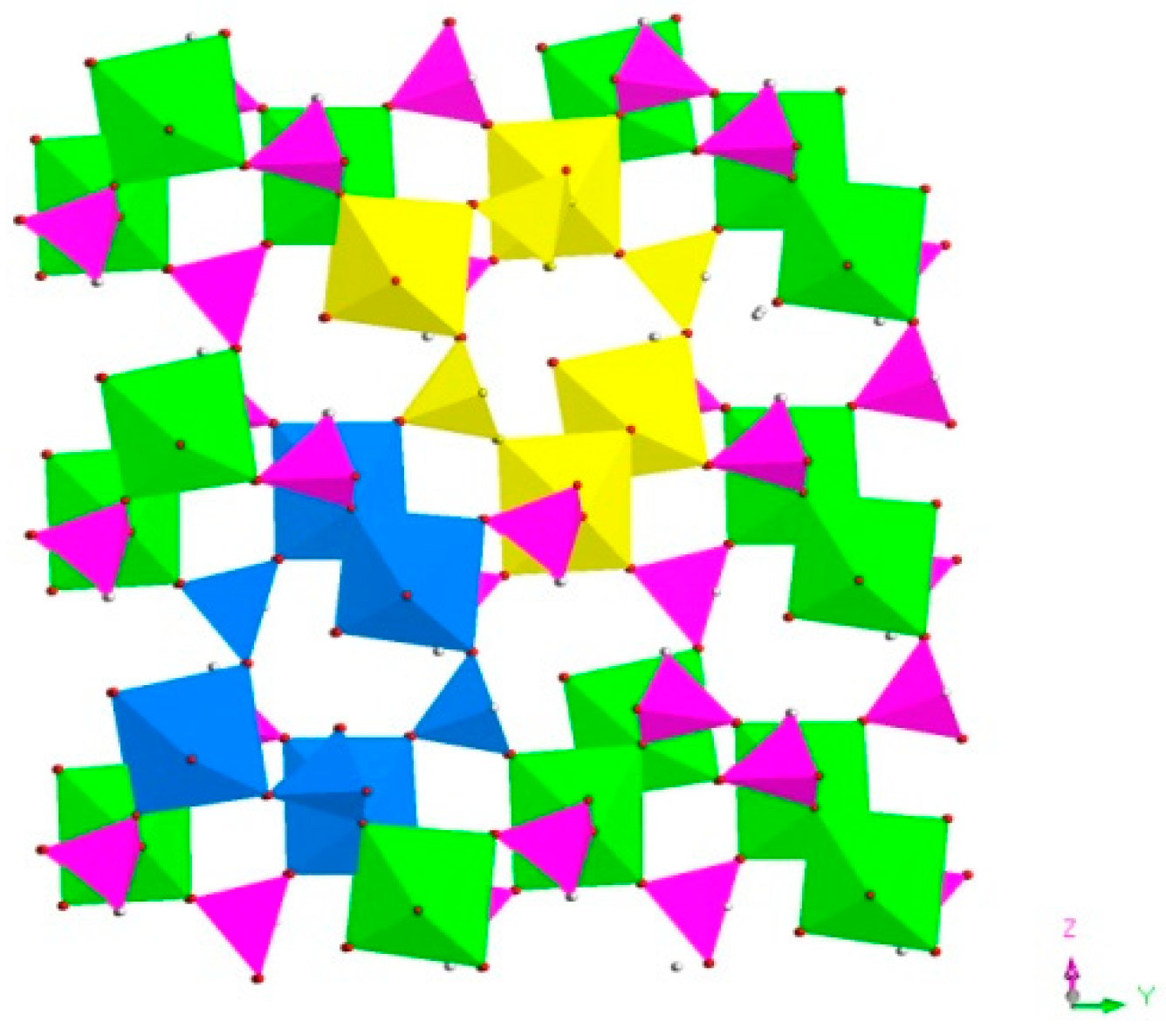

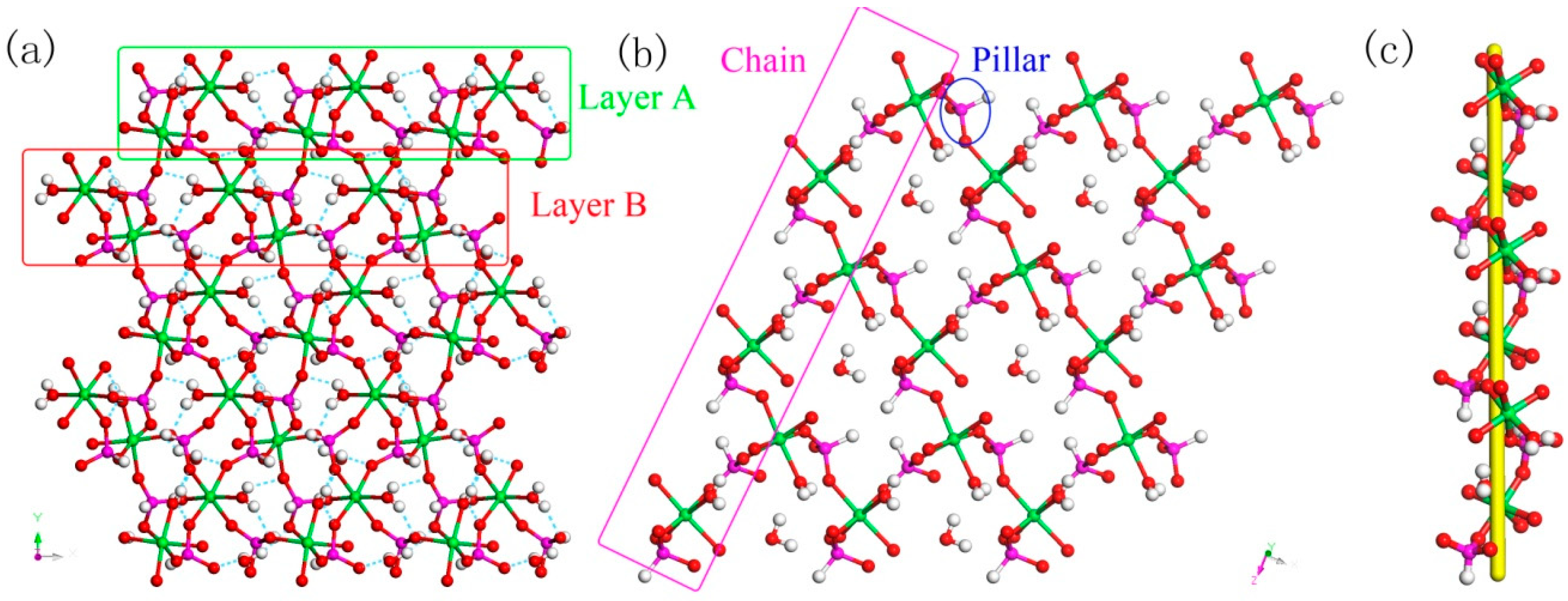


| 1 | 2 | 3 | 4 | |
|---|---|---|---|---|
| Empirical formula | C8N4H34Al2P4O18 | C3N2H17GaP2O8 | H5In2P3O10 | H11In2P3O13 |
| Formula weight | 651.96 | 340.83 | 487.59 | 541.62 |
| Temperature | 293(2) K | 293(2) K | 293(2) K | 296(2) K |
| Wavelength | 0.71073 Å | 0.71073 Å | 0.71073 Å | 0.71073 Å |
| Crystal system, space group | Orthorhombic, Pccn | Monoclinic, P21/c | Monoclinic, P21 | Monoclinic, P21 |
| Unit cell dimensions | a = 8.2701(12)Å b =16.791(2) Å c = 8.6711(13) Å α = 90.00° β = 99.110(4)° γ = 90.00° | a = 11.084(3) Å b = 7.093(2) Å c = 17.352(4) Å α = 90.00° β = 119.127(14)° γ = 90.00° | a = 6.6057(5) Å b = 10.1900(8) Å c = 7.5004(6) Å α = 90.00° β = 109.4560(10)° γ = 90.00° | a = 8.0064(5) Å b = 10.3793(6) Å c = 8.4640(5) Å α = 90.00° β = 113.3540(10)° γ = 90.00° |
| Volume | 1204.1(3) Å3 | 1191.7(5) Å3 | 476.04(6) Å3 | 645.74(7) Å3 |
| Z, Calculated density | 2, 1.704 Mg/m3 | 4, 1.889 Mg/m3 | 2, 3.402 Mg/m3 | 2, 2.775 Mg/m3 |
| Absorption coefficient | 0.474 mm−1 | 2.606 mm−1 | 5.385 mm−1 | 4.001 mm−1 |
| F(000) | 612 | 688 | 456 | 512 |
| Crystal size | 0.21 × 0.20 × 0.18 mm3 | 0.22 × 0.20 × 0.19 mm3 | 0.21 × 0.20 × 0.18 mm3 | 0.21 x 0.20 x 0.18 mm3 |
| Theta range for data collection | 2.43 to 28.38° | 2.10 to 28.42° | 2.88 to 28.31° | 2.62 to 28.33° |
| Limiting indices | −11 ≤ h ≤ 10, −22 ≤ k ≤ 22, −11 ≤ l ≤ 9 | −14 ≤ h ≤ 14, −7 ≤ k ≤ 9, −14 ≤ l ≤ 23 | −7 ≤ h ≤ 8, −12 ≤ k ≤ 13, −10 ≤ l ≤ 7 | −10 ≤ h ≤ 10, −10 ≤ k ≤ 13, −10 ≤ l ≤ 11 |
| Reflections collected/unique | 8066/1502 [R(int) = 0.0390] | 8121/2957 [R(int) = 0.0423] | 3502/2023 [R(int) = 0.0182] | 4778/2575 [R(int) = 0.0235] |
| Completeness to theta = 28.31 | 99.8% | 98.6% | 99.9% | 100.0% |
| Refinement method | Full-matrix least-squares on F2 | Full-matrix least-squares on F2 | Full-matrix least-squares on F2 | Full-matrix least-squares on F2 |
| Final R indices [I > 2σ(I)] | R1 = 0.0591, wR2 = 0.1929 | R1 = 0.0882, wR2 = 0.2064 | R1 = 0.0162, wR2 = 0.0408 | R1 = 0.0209, wR2 = 0.0470 |
| R indices (all data) | R1 = 0.0698, wR2 = 0.2029 | R1 = 0.0945, wR2 = 0.2075 | R1 = 0.0163, wR2 = 0.0409 | R1 = 0.0219, wR2 = 0.0474 |
© 2020 by the authors. Licensee MDPI, Basel, Switzerland. This article is an open access article distributed under the terms and conditions of the Creative Commons Attribution (CC BY) license (http://creativecommons.org/licenses/by/4.0/).
Share and Cite
Wang, X.; Dong, Z.; Meng, C.; Wang, W.; Yang, H.; Zhuo, X.; Yang, S. The Different Effects of Organic Amines on Synthetic Metal Phosphites/Phosphates. Materials 2020, 13, 1752. https://doi.org/10.3390/ma13071752
Wang X, Dong Z, Meng C, Wang W, Yang H, Zhuo X, Yang S. The Different Effects of Organic Amines on Synthetic Metal Phosphites/Phosphates. Materials. 2020; 13(7):1752. https://doi.org/10.3390/ma13071752
Chicago/Turabian StyleWang, Xuelei, Zhaojun Dong, Chao Meng, Wei Wang, Hairui Yang, Xizhun Zhuo, and Shaobin Yang. 2020. "The Different Effects of Organic Amines on Synthetic Metal Phosphites/Phosphates" Materials 13, no. 7: 1752. https://doi.org/10.3390/ma13071752





